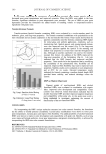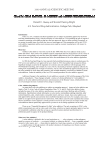REGULATION OF ECM REMODELING BY XANTHOHUMOL 129 inhibitor, which signifi cantly inhibited the activities of elastase and each of the MMPs (Figure 1a–d). STIMULATION OF EXPRESSION OF TYPES I, III, AND V COLLAGENS, ELASTIN, FIBRILLIN-1, AND FIBRILLIN-2 The identifi cation of natural products that inhibit MMPs and elastase, and simultaneously stimulate collagen and elastin fi ber formation, is ideal to counteract skin aging, which is Figure 2. Stimulation of expression of types I, III, and V collagens (a) and elastin, fi brillin-1, and fi brillin-2 (b) by 0.01%, 0.1%, and 1% xanthohumol or ascorbic acid (AA). Effect of xanthohumol or ascorbic acid is represented as % of control (0, no additives), represented at 100% *=p0.05, relative to control. Error bars represent standard deviation (n=4).
JOURNAL OF COSMETIC SCIENCE 130 associated with drastic deterioration of the structural ECM (1,2,12,13,15,18). The der- mal fi broblasts are the predominant cells responsible for the alterations in the ECM. Hence the effects of xanthohumol on the expression of ECM proteins were examined in these cells. Xanthohumol drastically increased expression of fi brillar collagen and elastin fi ber com- ponents, especially at 0.1%, where the effect was similar to that of ascorbic acid for col- lagens and about fourfold greater than the effect of ascorbic acid on elastin and fi brillin expression (Figure 2). Xanthohumol signifi cantly increased type I collagen expression transcriptionally in fi bro- blasts at 1% (protein: 224% of control promoter: 449% of control) and 0.1% (protein: 578% of control promoter: 1347% of control) (p0.05) (Figure 2a). Relative to the con- trol (0 at 100%), xanthohumol at 1% and 0.1%, respectively, signifi cantly stimulated the protein levels of type III collagen to 745% and 1390% of the control and type V collagen to 304% and 893% of the control (p0.05) (Figure 2a). Elastin expression was signifi cantly stimulated at the transcriptional level by xantho- humol at 1% (protein to 218% and promoter to 367%) and 0.1% (protein to 692% and promoter to 1288% relative to control) (Figure 2b). Xanthohumol at 0.1% and 1% sig- nifi cantly increased the expression of fi brillin-1 to 1823% and 603%, respectively, relative to the control, and fi brillin-2 expression to 1713% and 373% of the control, respectively (p0.05) (Figure 2b). CONCLUSION Xanthohumol has antioxidant and anti-infl ammatory properties, and thereby its po- tential for anti-skin-aging was investigated in this research. The targets examined were the extracellular matrix remodeling and structural proteins: elastase, MMP-1, MMP-2, MMP-9, types I, III, and V collagens, elastin, fi brillin-1, and fi brillin-2. Xanthohumol demonstrated dual protective effects on the extracellular matrix via the inhibition of the ECM proteolytic enzymes and the stimulation of the structural ECM components, collagens, elastin, and fi brillins. We identify xanthohumol as an anti-skin-aging agent via its benefi cial regulation of the ECM. The intake or topical application of xanthohumol may be benefi cial to skin health and preferred over hor- mones with similar effects (19). ACKNOWLEDGMENTS The authors thank Tiffany Chang, Joshua Givant, Sujini Yarlagadda, Marvin Tuason, and May Taw for their assistance. REFERENCES (1) M. H. Shin, G. E. Rhie, C. H. Park, K. H. Kim, K. H. Cho, H. C. Eun, and J. H. Chung, Modulation of collagen metabolism by the topical application of dehydroepiandrosterone to human skin, J. Invest. Dermatol., 124, 315–323 (2005). (2) J. Uitto, M. J. Fazio, and D. Olsen, Molecular mechanisms of cutaneous aging, J. Am. Acad. Dermatol., 21, 614–622 (1989).
Purchased for the exclusive use of nofirst nolast (unknown) From: SCC Media Library & Resource Center (library.scconline.org)





































































































































